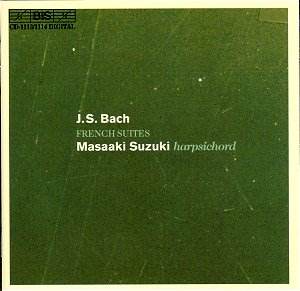Comparison Versions: Cates/Music
& Arts, Hogwood/Decca, Moroney/Virgin Classics
Masaaki Suzuki has achieved an enviable position
as a Bach performing artist of the highest order both as conductor
and keyboard player. His on-going series of the Bach Cantatas
consistently garners praise, and he also continues to record the
Bach keyboard works. Further, his recording of Bach’s German
Organ Mass is one of the finest on the market.
For his recording of the French Suites, Suzuki
plays a Willem Kroesbergen harpsichord built in 1982 after an
enlarged two-manual Ruckers. This is a gorgeous-sounding instrument
set in a soundstage of exceptional depth and clarity.
Suzuki’s performances also have much to
offer. Rhythms are supple, elegance is invested throughout the
set, and trills/ornamentation are enticing. Most significant,
Suzuki emphasizes the music’s all-important singing lines.
This is Bach playing of great beauty with smooth lines prevalent
in the Allemandes and sharp contours projected in the Courantes
and Gigues. I am most impressed with Suzuki’s performance
of the Gigue from Suite No. 5 that is Bach’s most compelling
and towering Gigue. The brilliance, energy, and bustling activity
of this music are wondrous, and Suzuki plays it with a controlled
abandon that is irresistible; he also fully captures the macabre
elements of the Gigue’s second section.
I do have a few reservations about the interpretations.
First, the rounded contours in the Allemandes are a bit cloying
in Suzuki’s hands. Second, changes in tempo and dynamics
are infrequent and narrow in range. Most damaging, Suzuki’s
treatment of the Sarabandes is a little under-nourished and generally
does not bring out the inherent emotional depth of these poignant
movements. An excellent example is the Sarabande of Suite No.
3 that is likely the most emotionally rich piece in all the Suites.
In this Sarabande, Bach takes us from deep remorse to acceptance
of our humanity, but Suzuki will not have any truck with remorse
because his schematic of the French Suites does not allow it to
intrude. The singing lines and beauty of form take priority.
Overall, Suzuki’s performances are within
the traditional mainstream. However, he does deviate greatly in
his interpretation of the Menuet from Suite No. 4. David Cates
and most other artists give this piece a slow tempo and much contemplation.
In contrast, Suzuki is quick and jaunty, changing the nature of
the music. His approach has its appeal, but I find the contemplative
route preferable. The sequence of Gavotte – Air –
Menuet – Gigue needs the Menuet to strongly contrast with
the three exuberant pieces. For whatever reason, Suzuki is not
interested in providing this contrast.
The two additional Suites offered on Disc 2 are
companion pieces that help fill up disc space and complement the
styles Bach uses in his French Suites. Surprisingly, I find Suzuki
more incisive in his phrasing in these two Suites and a fine alternative
to the exceptional recordings from Hogwood and Moroney.
In summary, Suzuki’s account of the French
Suites and their companion pieces has much to offer in terms of
exuberance, elegance, beauty of form, and emphasis on the singing
lines. Unfortunately, the readings are not exploratory nor do
they stress the architectural detail or emotional depth of Bach’s
music. More than anything else, ‘Bach is Beautiful’
is Suzuki’s calling card, and the set should be highly rewarding
to those who place top priority on gorgeous music. Personally,
I remain wedded to the comparison versions listed in the heading.
Don Satz


